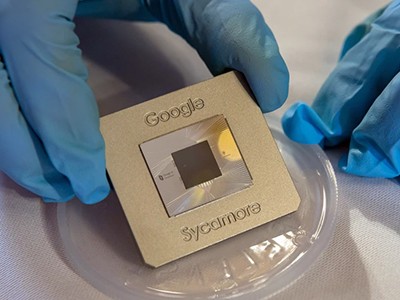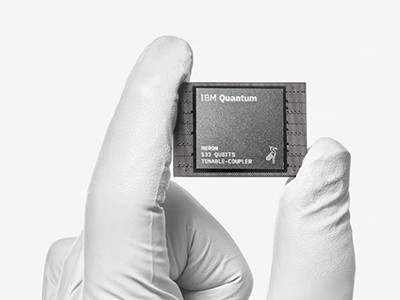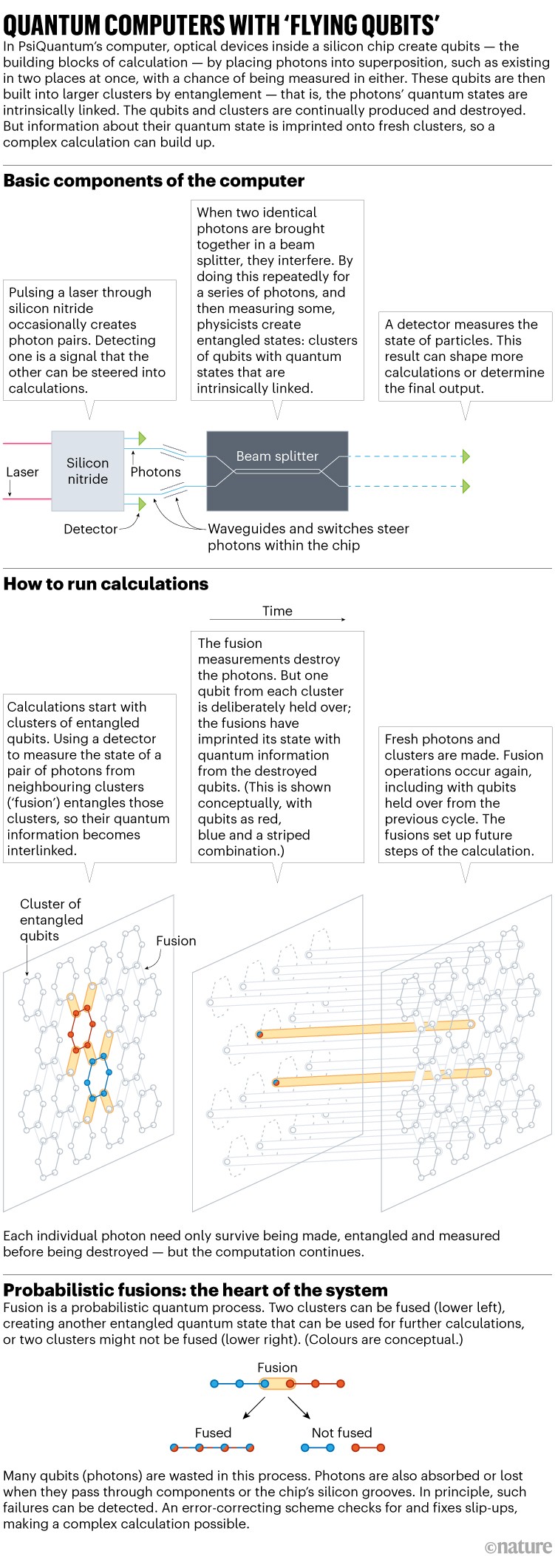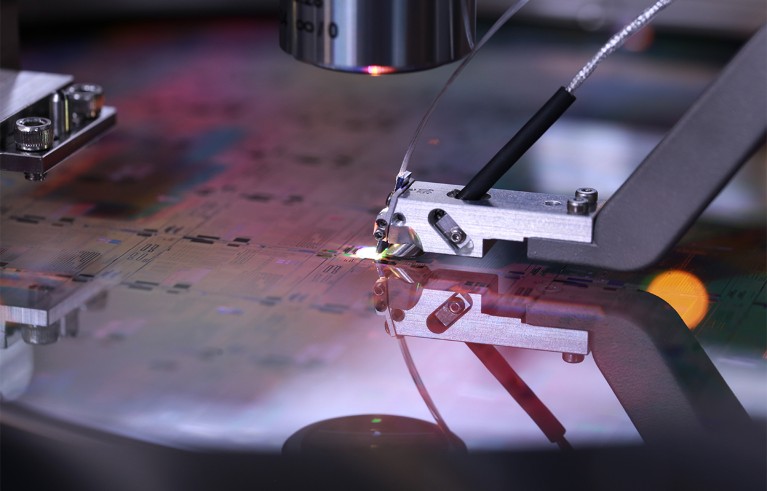Περιεχόμενα Άρθρου
A prototype cryogenic cabinet in which PsiQuantum is testing quantum computing using light in silicon chips.Credit: PsiQuantum
During his years in academia, Jeremy O’Brien says he had “precisely zero ambition to go into business”. Yet today, the Australian physicist runs a private quantum-computing firm that venture-capital funders and governments have rushed to invest in — and which is making some of the field’s boldest promises.
In a whirlwind nine years since O’Brien founded PsiQuantum with three academic colleagues, the company has quietly raised more than US$1 billion and values itself at more than $3 billion — meaning that its coffers probably rival those for internal quantum-computing efforts at Google or IBM. In the past year alone, PsiQuantum, which has 350 staff and is based in Palo Alto, California, has scored major investments from governments in Australia and the United States, adding to previous private funding rounds. “They have received one of the biggest venture-capital investments in the quantum community,” says Doug Finke, a computer scientist in Orange County, California, who works at the business-analysis firm Global Quantum Intelligence.
All that investment is chasing an audacious goal: using light in silicon chips to create a giant programmable quantum computer that can outperform classical machines — and to do it soon. By the end of 2027, the firm’s researchers told Nature, PsiQuantum aims to be operating a photonic quantum computer that can run commercially useful problems and is ‘fault-tolerant’: that is, it makes computations possible by correcting for the errors that are inherent in these fragile systems. If they succeed, this would put the firm ahead of its major rivals and leapfrog researchers doing toy problems on small-scale quantum computers.

Google uncovers how quantum computers can beat today’s best supercomputers
Yet compared with its competitors, PsiQuantum has shown very little. Rather than building up gradually, as others have done, by debuting systems of tens or hundreds of quantum bits, PsiQuantum is aiming to jump to a machine that will require something in the order of one million qubits. (PsiQuantum’s researchers haven’t published a specific number.) To do that, it will need to overcome technical challenges it has not proved it can solve, says Chao-Yang Lu, a physicist working on photonic quantum computing at the University of Science and Technology of China in Shanghai. He is one of several scientists who worry the firm is promising things it will struggle to deliver.
“My impression is there’s a lot of scepticism about how much progress PsiQuantum has made,” says Shimon Kolkowitz, a quantum physicist at the University of California, Berkeley. He calls a bet on them “extremely high risk”.
PsiQuantum researchers say the firm has achieved more than it has publicly shown, and that funders have scrutinized its plans. O’Brien himself talks about challenges in the past tense and insists that there is little doubt of success. And some independent researchers see its plans as being at least plausible. “I think it’s an amazing gamble,” says Pascale Senellart, a quantum optical physicist at the French National Centre for Scientific Research in Palaiseau. “It’s really worth exploring.”
Flying qubits
PsiQuantum’s approach is radically different to that of some major rivals (see ‘Comparing quantum computers’ at the end of this article), because of its choice of qubit — the basic unit of quantum information. Whereas the binary digits (bits) of classical computers encode either a 1 or a 0, qubits can be put into a ‘superposition’ — existing in two states at once, a combination of both 1 and 0, with a chance of being measured as either. Calculations come from ‘entangling’ these qubits, meaning that their quantum states become intrinsically linked and interdependent. To prevent errors from destroying the calculations, a quantum computer will need around 10,000 physical qubits working together to make each useful ‘logical’ qubit, O’Brien says. With a few hundred of these, researchers hope that quantum computers will be able to perform complex calculations, such as modelling chemical processes at the quantum level, that would be much too difficult for a classical machine.
Many firms in the field make their qubits from atoms, ions or tiny rings of a superconducting material — in each case, a physical object that has some mass and is often fixed in place. But PsiQuantum is one of a handful of companies that uses massless particles of light, or photons — sometimes known as flying qubits.
The idea to use light as a qubit isn’t new. In the early 2000s, optical quantum computing was one of the first platforms to be explored experimentally. Some of PsiQuantum’s founders were involved in the field’s birth, says Senellart, who is a co-founder of Quandela, a firm based near Paris that makes photonic quantum computers.
Making a quantum computer with light is “on paper, quite easy”, she says. PsiQuantum creates qubits by using an optical device called a beam splitter to send a single photon simultaneously down two routes (known as waveguides) etched into silicon. Because photons have no charge or mass, they are largely unaffected by their surroundings. This means that, even at room temperature, photon-based qubits are insensitive to many types of noise that plague rival hardware. This ability to maintain quantum information and travel long distances at speed makes it easy to build big and fast systems. “That’s a huge asset,” says Senellart.

IBM releases first-ever 1,000-qubit quantum chip
But photons also come with hurdles. It is hard to generate single, near-identical photons on demand. They are readily absorbed and lost. And getting the flighty particles to interact is a challenge. Although light waves do interfere with each other, that kind of interaction alone is not sufficient for constructing multi-qubit gates, in which qubits entangle to form basic logic operations.
To generate photons, the firm pumps laser light through silicon. These sources are probabilistic: they produce pairs of photons perhaps once in every 20 attempts. Having a pair is necessary because the spare, or ‘herald’, photon provides a heads-up that allows the computer to use the surviving photon.
With this strategy, each chip needs many such sources, as well as super-efficient waveguides and optical components that can handle photons without losing them.
To perform logic operations, PsiQuantum first builds up clusters of entangled photon qubits by bringing photons together so that their light waves interfere, then making measurements on some of them in ways that entangle the remaining qubits. Calculations then occur by performing a succession of such measurements on pairs of photons from different clusters. Those measurements destroy the pairs but entangle their clusters, a technique known as fusion-based quantum computing (see ‘Quantum computers with ‘flying qubits’’). Senellart says that PsiQuantum has an impressive team working on developing the theory behind such a computer. “They are coming up with a lot of smart schemes,” she says.

PsiQuantum’s approach continually generates and destroys photons, with each qubit needing to exist only for long enough to be entangled or measured with another, not for the duration of the calculation. And although each operation involves an element of chance and photons will get lost, failures are detectable as part of the measurement, says Mercedes Gimeno-Segovia, a physicist at PsiQuantum who is working on the computer’s architecture.
“It’s an incredibly forgiving way of doing quantum computing,” says Andrew White, an optical physicist at the University of Queensland in Brisbane, Australia, and a former academic colleague of O’Brien. “You can take very high error rates and still have it scale.”
PsiQuantum is not the only company pursuing quantum computing using light. Most firms plan to eventually scale up their systems by entangling devices using photonic qubits, so mastering them now makes sense, says Senellart. None is close to PsiQuantum’s billion-dollar backing. The company Xanadu, in Toronto, Canada, uses as its qubits ‘squeezed’ states, which encode information into the electromagnetic field of multiple photons. It has created a machine of more than 200 qubits and has raised a few hundred million dollars in funding. Quandela, which has raised $67.5 million, sells small machines that use on-demand sources of single photons, to boost efficiency and reduce a computer’s size. And ORCA Computing, based in London, is developing a way to store single photons as a short-term quantum memory; it has raised at least $15 million.
PsiQuantum’s pitch
PsiQuantum’s physicists say they have the advantage of building on the foundations of two existing mega industries: semiconductor manufacturing for computers, and photonics, which creates the fibre optics used in telecommunications cables. The firm’s chips — made in partnership with US semiconductor giant Global Foundries — combine conventional technology such as beam splitters with components such as single-photon detectors and sources, which are rarely used outside laboratories. These are all etched onto silicon wafers, where they manipulate telecoms-frequency photons.
“In a way, we’re taking existing technologies and making them behave quantum mechanically, as opposed to inventing completely new technology, then trying to figure out how to scale it,” says Mark Thompson, one of PsiQuantum’s co-founders and its chief technologist.
For its system to work, the company needs millions of precision electronic components that must operate at unprecedented efficiency and can’t simply be taken off the shelf. Detectors, for example, need to be chilled to around 4 kelvin using liquid helium. The biggest challenge, says O’Brien, has been creating optical switches to divert photons into calculations. For this, the company built its own facility to grow high-purity wafers of barium titanate, a material that can steer light efficiently. The firm spent a vast amount of money and made a big bet, says O’Brien: this leap of faith is one of the things he is proudest of.
Outsiders must take O’Brien and his colleagues largely at their word that they have solved such challenges. The firm, which once had a reputation for being secretive, is starting to open up. In April, it published a preprint outlining its hardware platform, which White calls jaw-dropping (K. Alexander et al. Preprint at arXiv https://doi.org/gtzxqj; 2024). It shows efficiencies, such as in getting light off a chip into a fibre, that are “well ahead of what the best university labs could do”, he says.

A PsiQuantum silicon photonic wafer being tested at the firm’s facility in Palo Alto, California.Credit: PsiQuantum
Some of the demonstrations in the paper are “extremely impressive”, says Senellart. But others are missing, such as the rate of photons produced per second, she adds. What’s more, some of the numbers are not as good as they need to be, says Graeme Smith, a quantum physicist at the University of Waterloo in Canada. For example, he says, the likelihood that a heralded particle is detected is reported as 26%, when it needs to be more than 50%. “It is not encouraging that, after many years, they are still struggling with good single photon sources, since it is the most basic building block of their proposed architecture,” he says. Any photonic quantum computer will need to reduce photon losses to levels never previously demonstrated at scale, says Stephanie Simmons, a quantum physicist at Simon Fraser University in Burnaby, Canada.
In response, Thompson says the team’s papers are “just the tip of the iceberg” of what PsiQuantum has achieved. Commercial secrecy might be one reason that the team is not publishing its best work. “To publish in academic journals is very time-consuming and quite a distraction,” he says.
But PsiQuantum’s approach also feels like a gamble, says Senellart, because it has opted not to publicly show small demonstrations, often called noisy intermediate-scale quantum (NISQ) devices. “Personally, I would sleep better” with the incremental approach, she says. If the firm can manage without, “it’s just amazing”.
Missing out this stage means no working prototypes are available, and has irked academics who like to see concrete milestones. With no NISQ computer, the firm has been less active than some at recruiting end users or software partners, says Finke, adding to its air of mystery. White says: “Publicly, they haven’t demonstrated in their papers anything other than entanglement between a couple of photons.”




